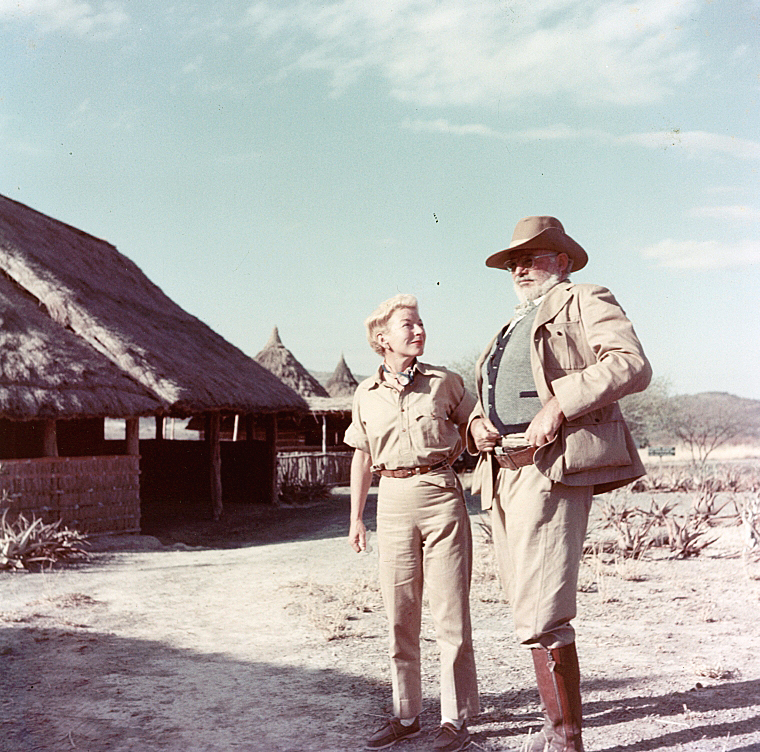Mary Welsh Hemingway
Dr. Hilary Justice (JFK Library). Updated 11/2023
In World War II London, awaiting D-Day, Ernest Hemingway met war correspondent Mary Welsh (1908-1986), who would become his wife, widow, and the initial custodian of his literary legacy.
![A black and white image titled Six War Correspondents: Text reads: Mary Welch [sic], Dixie Tighe, Kathleen Harriman, Helen Kirkpatrick, Lee Miller, and Tania Long, War Correspondents, 1943. Six women wearing U.S. WW2 uniforms sit on a concrete wall. One holds a small movie camera.](/sites/default/files/2023-10/Mary%20Welsh%20w%20war%20corres%20wwii%20www%20history%20army%20mil%20-%20ww2eto%20nara_0.jpeg)
Although Mary did not have the celebrity of Hemingway's third wife, Martha Gellhorn, before she met Hemingway, Mary was already a high-flyer in the world of war journalism. She was the first woman war journalist named to the London branch for a major U.S. magazine. While in London, Mary moved in the highest circles; her work included broadcasts for the BBC and several documentaries designed to increase U.S. awareness of the effects of the war on the British home front.
Watch the documentaries Women at War (Mary Welsh, writer) and Rationing in Britain (Mary Welsh, writer and narrator) at the Imperial War Museums film archive.
After Hemingway's divorce from Martha Gellhorn on December 21, 1945, Mary joined him in Cuba, where they married on March 14, 1946.
They made their home at the Finca Vigia in San Francisco de Paula until the Revolution and Hemingway's health forced a permanent relocation to the United States--to Ketchum, Idaho. She recounts their life together in the autobiographical How It Was.
As with all of Hemingway's wives, she proved inspiring to Hemingway’s last works, especially True at First Light, the “fictional memoir” of their 1953-54 safari, in which she appears as Miss Mary.
Her influence on his other works is more subtle.
Mary was a talented photographer with a keen artistic eye; the Ernest Hemingway Personal Photographs Collection contains hundreds of her photographs, ranging from the intimate to the documentary.
Mary's camera work changes, apparently at will, from creating a factual documentary record to capturing fleeting moments of atmosphere and intimacy, almost as though she set herself specific assignments with each roll of film.
Several groups of her photographs seem consciously designed to provide her husband with visual reference material for his writing, particularly those she took recording the most mundane aspects of a duck hunt in the Veneto region of Italy, taken as Hemingway was developing his thoughts for Across the River and into the Trees.
Her friendship with Ernest's second wife, Pauline Pfeiffer, developed while Patrick Hemingway (Pauline’s son with Ernest) was at the Finca Vigía recovering from an illness. Pauline flew to Cuba to care for her son; Mary had been called back to the United States to deal with family matters. After Mary returned, their friendship grew. That friendship, as well as aspects of Mary’s personality and appearance, are reflected in composite characters and some of the details of The Garden of Eden.
Mary and Ernest Hemingway’s marriage had more than its share of difficulties, foremost among them his failing health and despair, all exacerbated and accelerated by the severe head injury he suffered in a plane crash while in Africa.

After the Revolution in Cuba, both decided that, as Americans, they could no longer return, whether or not they wanted to.
Although they both loved their final home Idaho, which they decorated with mementos from their travels, their lives there were shadowed by mourning and increasing loss, enlivened only in fleeting moments – a chance encounter with a friendly dog; nursing an injured bird back to health—coming to an end with Hemingway’s suicide on July 2, 1961.
Mary Hemingway donated the Ernest Hemingway Collection to the JFK Library and established the annual PEN/Hemingway Award. She divided her time between Idaho and New York until her death in 1986.
Watch the JFK Library Forum with Timothy Christian, discussing Hemingway's Widow, his biography of Mary Welsh Hemingway.
